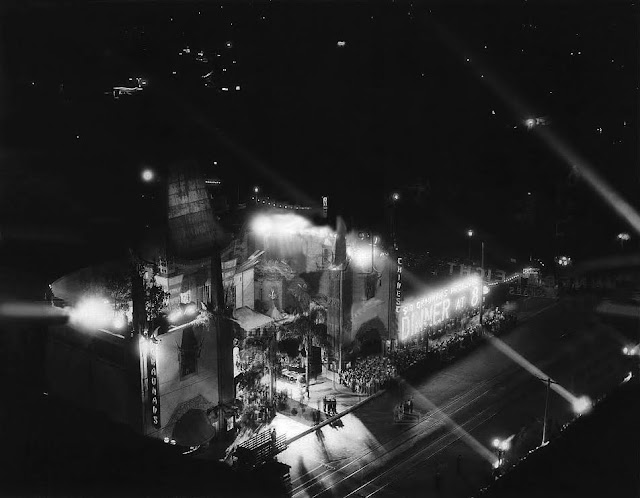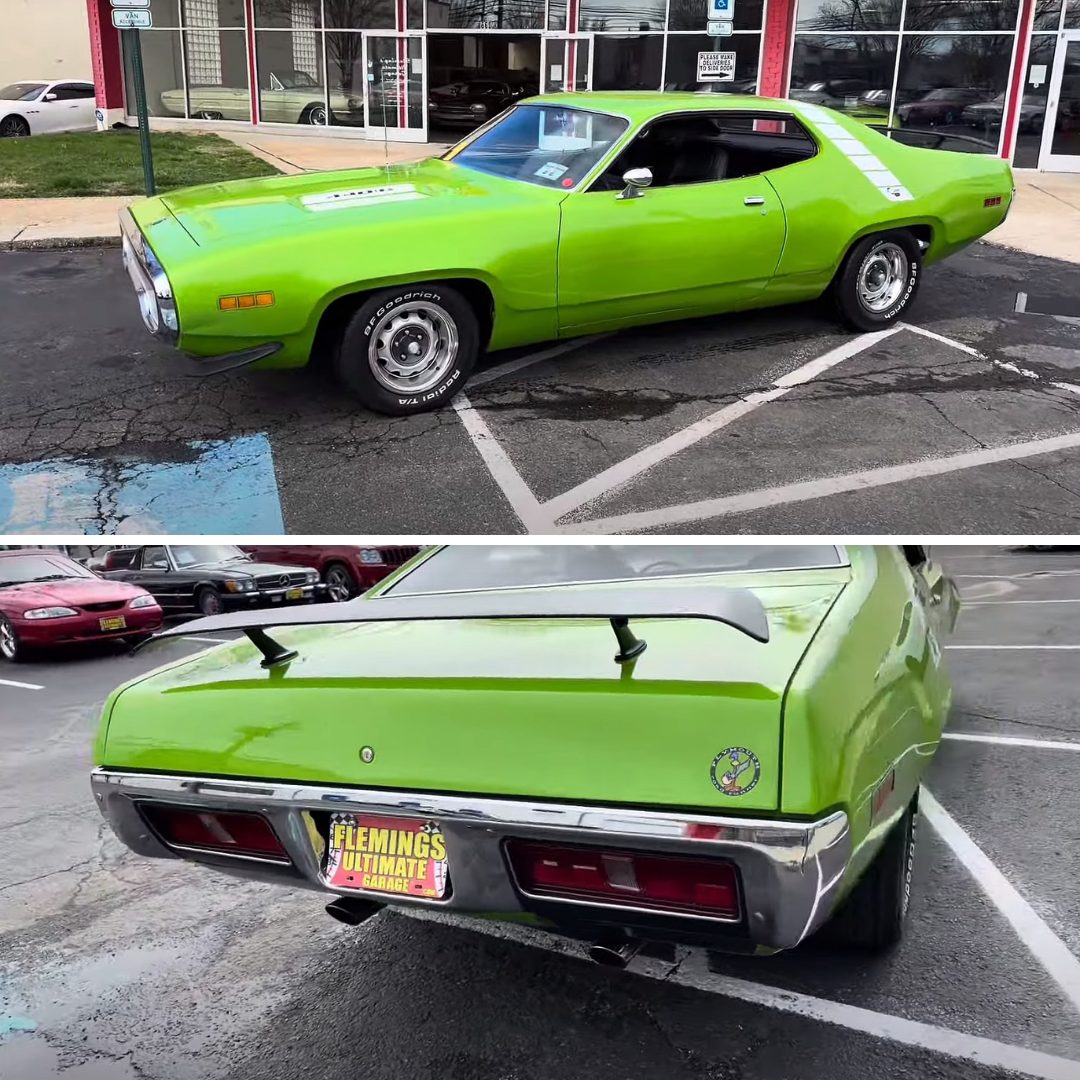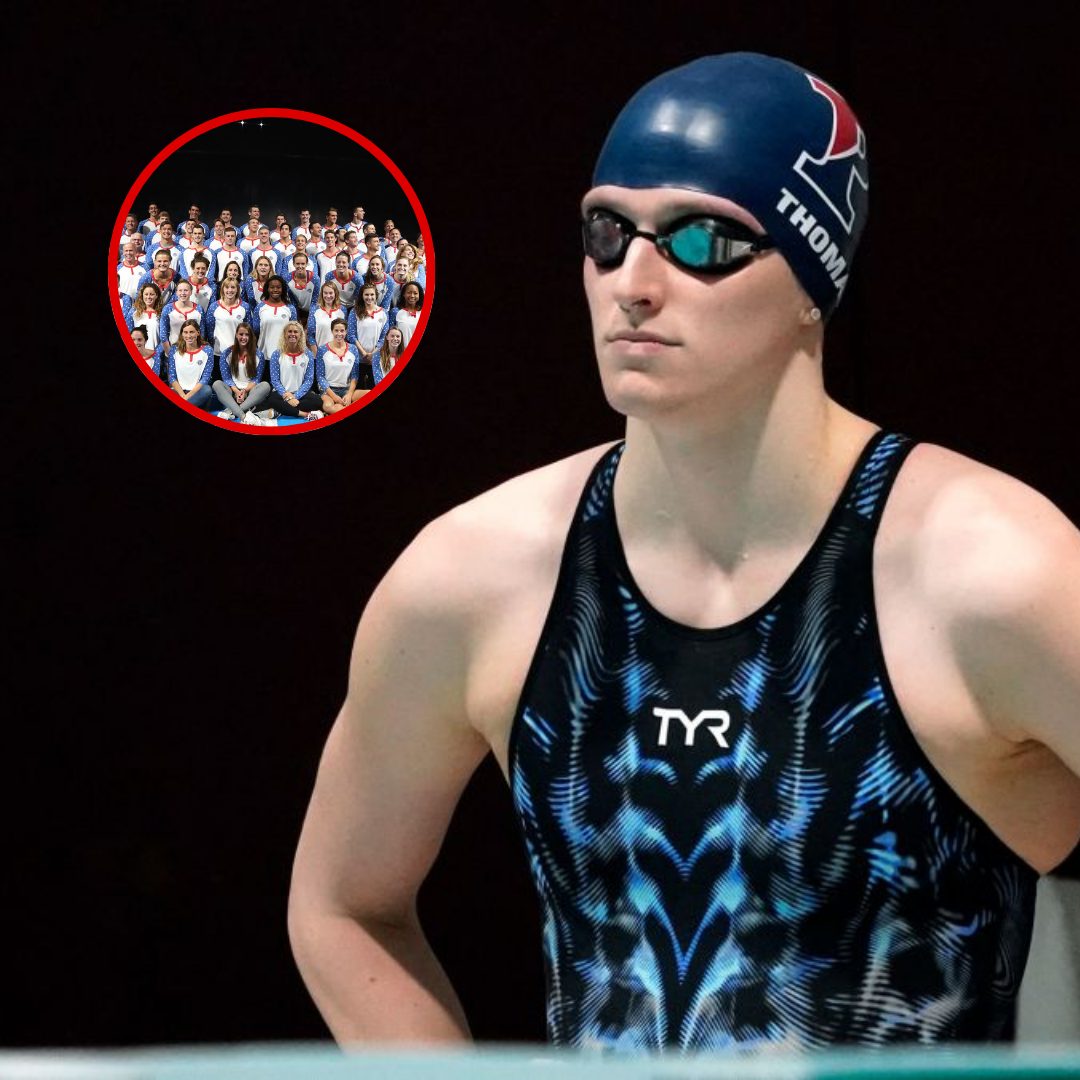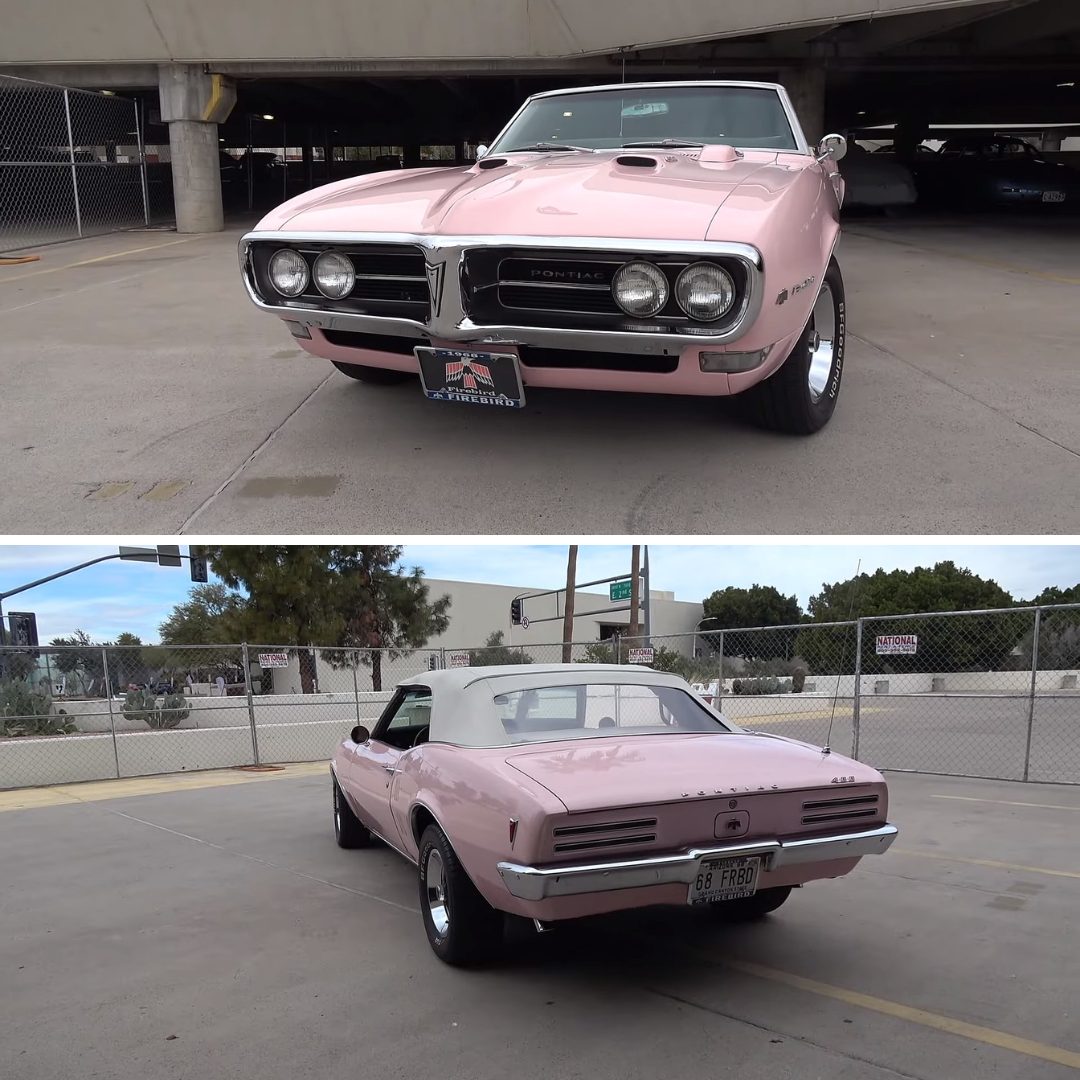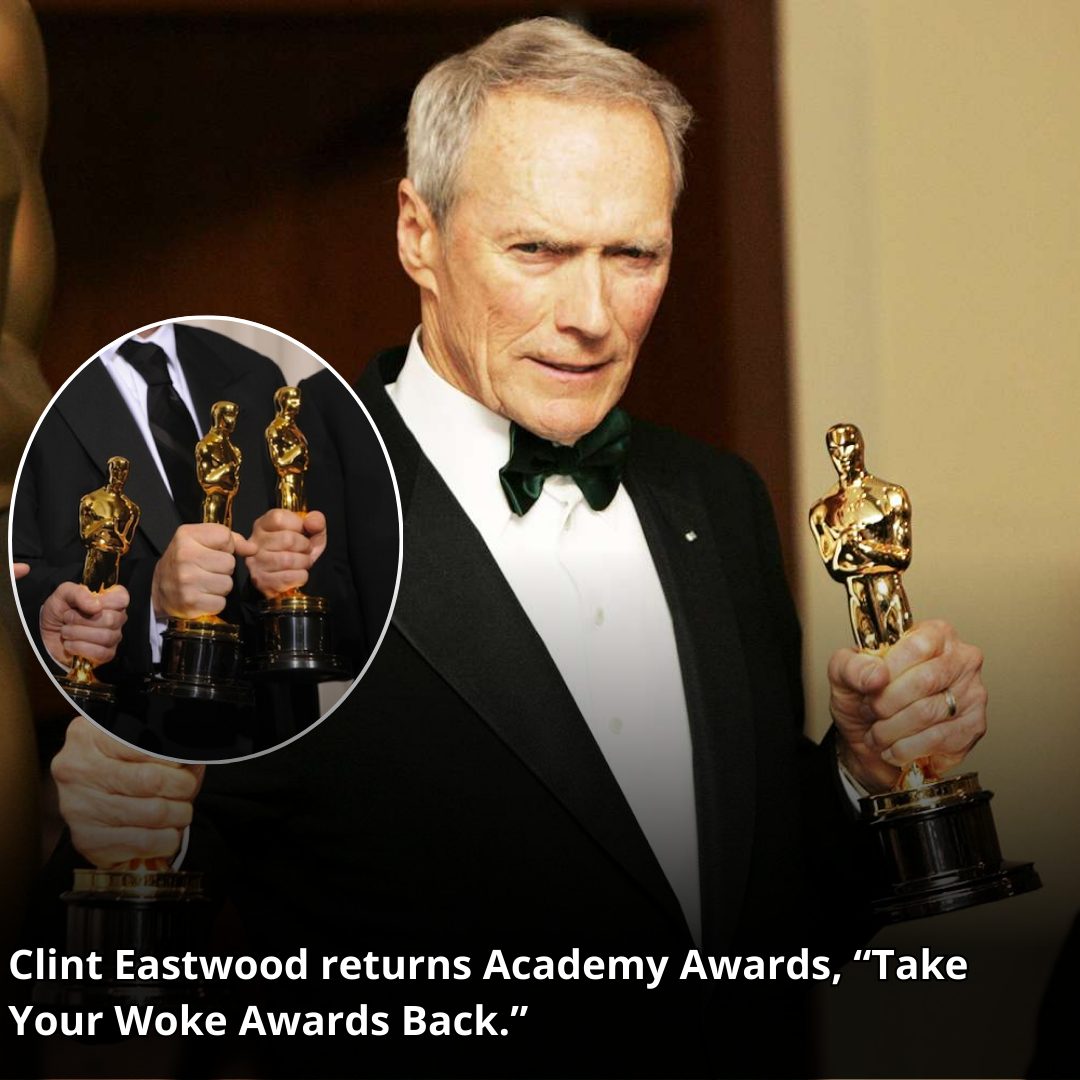The Grauman’s Chinese pages: | Chinese overview | street views 1926 to 1954 | street views 1955 to present | forecourt | lobby | lounges | vintage auditorium views | recent auditorium views | upstairs boxes and offices | booth | stage | basement | attic and roof | Chinese Twin | Chinese 6 |

1926 – Excavation is beginning. Hollywood Blvd. is on the left. Note the partially built construction fence. Thanks to the Chinese Theatre for including the photo in a post on their Facebook page on the occasion of the theatre’s 95th anniversary. Earlier, Ken McIntyre had located a version to include in a thread about the construction on the private Facebook group Photos of Los Angeles.
A slightly clopped version of the image appears in the wonderful Bruce Torrence Historic Hollywood Photographs collection, their #T-017-5. Also see an earlier view with lumber on the site but no digging started their #T-017-1. At last look they had 387 images of the Chinese Theatre to browse. The collection is now owned by the McAvoy family. 
1926 – A closer look at the steamshovel at work. The stage end of the dig is over on the left. It’s an image from the McAvoy/Bruce Torrence Historic Hollywood Photographs collection, their #T-017-4. Also see another view they have in the collection taken after a bit more excavation, their #T-017-3.
 1926 – A September look east as the steel rises for the Chinese. At the top is the Hollywood Hotel. At the bottom is the chi-chi Garden Court Apartments. Thanks to Ken McIntyre for finding the photo. It was a post on the private Facebook group Photos of Los Angeles.
1926 – A September look east as the steel rises for the Chinese. At the top is the Hollywood Hotel. At the bottom is the chi-chi Garden Court Apartments. Thanks to Ken McIntyre for finding the photo. It was a post on the private Facebook group Photos of Los Angeles.
 1927 – The theatre with the construction fence still up and scaffolding on the pagoda. The photo appeared as part of an article and photo spread on pages 18 and 19 in the April 16 issue of Exhibitors Herald. See the continuation of the article on pages 39 and 40. Thanks to Mike Hume for spotting this on Internet Archive. For a real treat see the page about the Chinese on his Historic Theatre Photography site.
1927 – The theatre with the construction fence still up and scaffolding on the pagoda. The photo appeared as part of an article and photo spread on pages 18 and 19 in the April 16 issue of Exhibitors Herald. See the continuation of the article on pages 39 and 40. Thanks to Mike Hume for spotting this on Internet Archive. For a real treat see the page about the Chinese on his Historic Theatre Photography site.
 1927 – A postcard view from above by Burton Frasher taken prior to the theatre’s opening. Michelle Gerdes found it on eBay. The Harold Lloyd footprint insert on the left was added later.
1927 – A postcard view from above by Burton Frasher taken prior to the theatre’s opening. Michelle Gerdes found it on eBay. The Harold Lloyd footprint insert on the left was added later.
 1927 – A wider, non-postcard version of the previous image. The photo by Burton Frasher, Sr. (1888-1955) appears in a 90th Birthday album on the TCL Chinese Facebook page. It can also be seen on Internet Archive, with three other views, in the June 11, 1927 issue of Exhibitors Herald. Kurt Wahlner, curator of the history site GraumansChinese.org, notes that the sign for “King of Kings” is visible in the forecourt and the storefront windows were still covered. He likes that they were still growing vegetables next door when the Chinese opened.
1927 – A wider, non-postcard version of the previous image. The photo by Burton Frasher, Sr. (1888-1955) appears in a 90th Birthday album on the TCL Chinese Facebook page. It can also be seen on Internet Archive, with three other views, in the June 11, 1927 issue of Exhibitors Herald. Kurt Wahlner, curator of the history site GraumansChinese.org, notes that the sign for “King of Kings” is visible in the forecourt and the storefront windows were still covered. He likes that they were still growing vegetables next door when the Chinese opened.
Kurt adds: “Grauman’s Chinese sits under the warm California sun just prior to its opening in May, 1927. The theatre is 140 feet wide by 250 feet deep. Since land was cheaper in Hollywood at the time, Grauman envisioned a spacious theatre with no balcony, the largest stage in Hollywood, and a large forecourt area, where patrons could mill about during the intermission between his lavish stage prologues and the feature film. Note the fact that there is no conventional marquee. Subsequent operators would fix this problem, but Grauman did not want much signage at the theatre — at first.”
 1927 – Getting ready for the opening. Note the “King of Kings” sign near the front doors. The photo was on the Brittanica Blog at one time but has now vanished from their site.
1927 – Getting ready for the opening. Note the “King of Kings” sign near the front doors. The photo was on the Brittanica Blog at one time but has now vanished from their site. 
1927 – A pre-opening view by J.C. Milligan. Five years earlier Milligan had taken a number of pre-opening shots of Grauman’s Egyptian. Thanks to the theatre for sharing this version of the photo on the TCL Chinese Theatres Facebook page. It can also be seen on page 26 of Ronald Haver’s 1980 book “David O. Selznick’s Hollywood.” Haver credits the photo to Marc Wanamaker’s Bison Archives. Victor Ver shared that version on the Lost Angeles Facebook group.
On Kurt Wahlner’s superb page “A Tour of Grauman’s Chinese Theatre 1927” he comments: “This photo was taken from the roof of the one-story building across the street from the Chinese. The Chinese had been designed and built by Meyer & Holler Inc., a construction company whose chief designer was a man named Raymond M. Kennedy. What Kennedy came up with for the Chinese certainly has no architectural predecessors — not even people familiar with Chinese architecture know how to classify it — and it is this uniqueness which has made it the most photographed building in Los Angeles.”  1927 – Thanks to Brian Michael McCray for this pre-opening postcard view of the theatre. It’s one of over 400 cards in his collection, until recently all viewable on Picasa — but Google has now pulled the plug on that platform.
1927 – Thanks to Brian Michael McCray for this pre-opening postcard view of the theatre. It’s one of over 400 cards in his collection, until recently all viewable on Picasa — but Google has now pulled the plug on that platform.
 1927 – Did you like Brian’s colorful card? This card uses the photo it was based on. It’s in the collection of the California State Library.
1927 – Did you like Brian’s colorful card? This card uses the photo it was based on. It’s in the collection of the California State Library.  1927 – A pre-opening postcard from the California State Library collection, their #001528644. The paper was down in the storefront windows but no posters yet in the display cases.
1927 – A pre-opening postcard from the California State Library collection, their #001528644. The paper was down in the storefront windows but no posters yet in the display cases. 
1927 – A May 18 opening night view from the collection of Kurt Wahlner. He notes that the snipe on the back is headlined “Movie Stars Throng to Opening of New Los Angeles Movie Palace.”
 1927 – An opening night photo from the Los Angeles Public Library collection.
1927 – An opening night photo from the Los Angeles Public Library collection.
 1927 – A small portion of the opening night crowd of 50,000. The photo appeared on page 23 of the May 28 issue of Exhibitors Herald. The theatre’s opening bill was reviewed on page 39 of the same issue. Thanks to Mike Hume for spotting the article on Internet Archive. See the page he’s done about the Chinese on the Historic Theatre Photography site. A wider, but fuzzier, version of this photo is in the Los Angeles Public Library collection.
1927 – A small portion of the opening night crowd of 50,000. The photo appeared on page 23 of the May 28 issue of Exhibitors Herald. The theatre’s opening bill was reviewed on page 39 of the same issue. Thanks to Mike Hume for spotting the article on Internet Archive. See the page he’s done about the Chinese on the Historic Theatre Photography site. A wider, but fuzzier, version of this photo is in the Los Angeles Public Library collection.  1927 – Another fine opening night image from Kurt Wahlner’s collection. This one was included in a post on his GraumansChinese.org Facebook page on the occasion of the theatre’s 95th 𝐛𝐢𝐫𝐭𝐡day. Thanks, Kurt!
1927 – Another fine opening night image from Kurt Wahlner’s collection. This one was included in a post on his GraumansChinese.org Facebook page on the occasion of the theatre’s 95th 𝐛𝐢𝐫𝐭𝐡day. Thanks, Kurt!  1927 – A matinee crowd for “King of Kings.” It’s a photo in the AMPAS Tom B’hend and Preston Kaufmann Collection, a part of the Margaret Herrick Library Digital Collections. At this point there was still no tenant in that left storefront.
1927 – A matinee crowd for “King of Kings.” It’s a photo in the AMPAS Tom B’hend and Preston Kaufmann Collection, a part of the Margaret Herrick Library Digital Collections. At this point there was still no tenant in that left storefront.  1927 – A “King of Kings” shot from the L.A. Chamber of Commerce collection appearing on the USC Digital Library website. A tenant was at work on that left storefront. With the flags and banners out it looks like it might have been a photo taken around Memorial Day.
1927 – A “King of Kings” shot from the L.A. Chamber of Commerce collection appearing on the USC Digital Library website. A tenant was at work on that left storefront. With the flags and banners out it looks like it might have been a photo taken around Memorial Day.  1927 – Another photo taken during the run of “King of Kings.” Thanks to Eric Lynxwiler for sharing this from his collection on Flickr. And also thanks to Michelle Gerdes for including this in the Los Angeles Historic Theatre Foundation Group Pool on Flickr. It’s a great look at all the foliage atop the parapet wall.
1927 – Another photo taken during the run of “King of Kings.” Thanks to Eric Lynxwiler for sharing this from his collection on Flickr. And also thanks to Michelle Gerdes for including this in the Los Angeles Historic Theatre Foundation Group Pool on Flickr. It’s a great look at all the foliage atop the parapet wall.  1927 – A detail from Eric’s “King of Kings” photo. That’s Cecil B. DeMille in the left display case.
1927 – A detail from Eric’s “King of Kings” photo. That’s Cecil B. DeMille in the left display case.  1927 – Another detail from Eric’s photo. Note the costumed individual at the center. At the far left there’s a floral tribute from West Coast Theatres. Thanks, Eric!
1927 – Another detail from Eric’s photo. Note the costumed individual at the center. At the far left there’s a floral tribute from West Coast Theatres. Thanks, Eric!  1927 – A “King of Kings” postcard based on the photo from the Eric Lynxwiler collection seen above. Note the floral tribute back near the boxoffice at the rear of the forecourt. The card is one that popped up on eBay. Note that the card’s colorist added some merchandise in the windows of the left storefront.
1927 – A “King of Kings” postcard based on the photo from the Eric Lynxwiler collection seen above. Note the floral tribute back near the boxoffice at the rear of the forecourt. The card is one that popped up on eBay. Note that the card’s colorist added some merchandise in the windows of the left storefront.  1927 – [with additions!] – It’s the same 1927 “King of Kings” shot as in the last card except those dated cars in front have vanished and we now have a canopy out to the street and a boxoffice at the sidewalk, something that didn’t get installed until 1934. The card appears in a number of collections including in Elizabeth Fuller’s wonderful Old Los Angeles Postcards album on Flickr. They were still selling this card as late as 1953, the postmark on the copy she has. On the rear: “The Chinese Theatre has been the scene of Hollywood’s greatest premieres. In the forecourt of this famous theatre may be seen the foot-prints in the cement of many of filmland’s celebrities, both past and present.”
1927 – [with additions!] – It’s the same 1927 “King of Kings” shot as in the last card except those dated cars in front have vanished and we now have a canopy out to the street and a boxoffice at the sidewalk, something that didn’t get installed until 1934. The card appears in a number of collections including in Elizabeth Fuller’s wonderful Old Los Angeles Postcards album on Flickr. They were still selling this card as late as 1953, the postmark on the copy she has. On the rear: “The Chinese Theatre has been the scene of Hollywood’s greatest premieres. In the forecourt of this famous theatre may be seen the foot-prints in the cement of many of filmland’s celebrities, both past and present.”
The card is also in the Cinema Postcards From the Americas collection of Roloff de Jeu on Flickr. He notes it’s a Curt Teich card and the publication date is on the card. He says “In the right bottom corner, you see a code, 1A-H445. The A is for the Thirties (B for Forties, C for Fifties, etc.), the 1 is for the first year, so it’s from 1931.” The card also appears in the collection of Michelle Gerdes on Flickr.
 1927 – A Mott Studios look at the left side of the facade taken during the run of “King of Kings.” That’s a picture of Cecil B. DeMille in the left display case. This is in the California State Library collection, with two other views, as #001535404. The image also made an appearance on page 83 of the January 1928 issue of Architectural Digest as part of a four-page article about the theatre. Thanks to Scott Collette for locating the issue. He curates the Facebook page Forgotten Los Angeles.
1927 – A Mott Studios look at the left side of the facade taken during the run of “King of Kings.” That’s a picture of Cecil B. DeMille in the left display case. This is in the California State Library collection, with two other views, as #001535404. The image also made an appearance on page 83 of the January 1928 issue of Architectural Digest as part of a four-page article about the theatre. Thanks to Scott Collette for locating the issue. He curates the Facebook page Forgotten Los Angeles.  1927 – The second Mott Studios “King of Kings” photo in the California State Library set #001535404.
1927 – The second Mott Studios “King of Kings” photo in the California State Library set #001535404.  1927 – The last Mott Studios “King of Kings” photo in the three-photo California State Library set #001535404. Also see a similar shot with slightly different cropping and different action at the doors. It’s in the Library’s collection as #001386271, a three-photo set that includes forecourt and auditorium views. There’s also a copy of the latter image indexed as #001535416.
1927 – The last Mott Studios “King of Kings” photo in the three-photo California State Library set #001535404. Also see a similar shot with slightly different cropping and different action at the doors. It’s in the Library’s collection as #001386271, a three-photo set that includes forecourt and auditorium views. There’s also a copy of the latter image indexed as #001535416. 
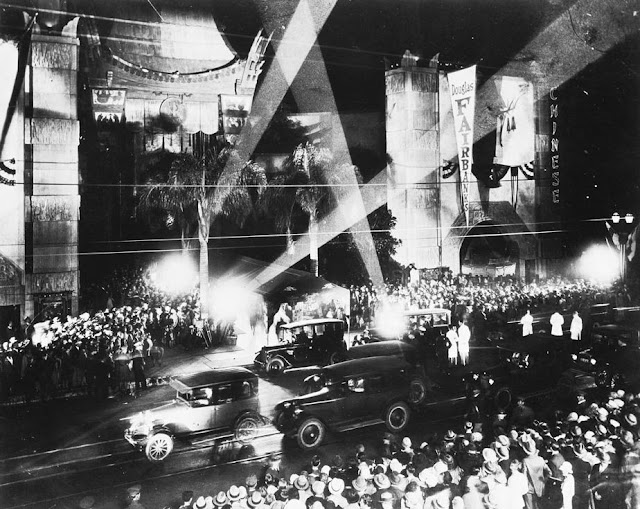 1927 – A USC Digital Library collection photo of a Douglas Fairbanks premiere from the Los Angeles Chamber of Commerce collection. There’s also a copy in the Los Angeles Public Library collection. The USC collection also has another view of the same event. Chinese Theatre historian Kurt Wahlner advises that there was only one Fairbanks premiere at the theatre: “The Gaucho,” November 4, 1927.
1927 – A USC Digital Library collection photo of a Douglas Fairbanks premiere from the Los Angeles Chamber of Commerce collection. There’s also a copy in the Los Angeles Public Library collection. The USC collection also has another view of the same event. Chinese Theatre historian Kurt Wahlner advises that there was only one Fairbanks premiere at the theatre: “The Gaucho,” November 4, 1927.
 1927 – A photo of the November 4 premiere for “The Gaucho” that appeared in the December 3 issue of Exhibitors Herald. Thanks to Mike Hume for finding it on Internet Archive. The photo appeared with this caption: “It was a gala night when Douglas Fairbanks’ new picture ‘The Gaucho’ opened at Sid Grauman’s new Chinese theatre in Hollywood. The throng is awaiting the arrival of the United Artists star.”
1927 – A photo of the November 4 premiere for “The Gaucho” that appeared in the December 3 issue of Exhibitors Herald. Thanks to Mike Hume for finding it on Internet Archive. The photo appeared with this caption: “It was a gala night when Douglas Fairbanks’ new picture ‘The Gaucho’ opened at Sid Grauman’s new Chinese theatre in Hollywood. The throng is awaiting the arrival of the United Artists star.” 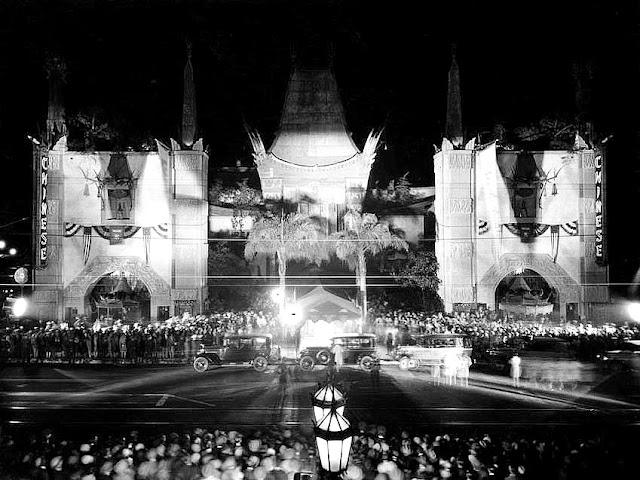

c.1928 – Aaah, the famous yellow skies of Hollywood. This card appears in many collections. Note that by this time two of the forecourt’s palm trees had been removed. The card is one of 11 vintage theatre cards appearing with Patt Morrison’s “Financial ruin. Possible destruction. What will be the Cinerama’s Hollywood ending?,” an April 20, 2021 L.A. Times article about the fate of various L.A. theatres over the last 100+ years. Thanks to Donavan S. Moye and Jonathan Raines for spotting the story. Also see the version of the yellow skies card in Elizabeth Fuller’s Old Los Angeles Postcards collection on Flickr.
The copy of the card Patt found had this copy on the back: “This world-famous theatre is the scene of some most spectacular Premieres. In the cement paving of the forecourt prominent stars, both past and present, have left their hand and footprints as mementos to their admiring public.”

1928 – A Louis Stellman photo in the collection of the California State Library, their item #001384962. Note the thatched hut. Chinese Theatre historian Kurt Wahlner notes that the photo is from the August 3 to October 21 run of “White Shadows In The South Seas,” the first talkie to play the Chinese. It was also the film that triggered David Lean’s desire to make movies.
Kurt says: “The couple embracing in the left poster case is the same as that as you see on the sheet music for the film – very little paper exists on this film, which is rather a good movie.” He notes that in this photo there are no heaven dogs at the entrance. Also, as seen seen in the November 1927 view of “The Gaucho” premiere, “the stenciled awning was there from the very beginning. They were a little bit freer with taking it in and setting it back up then, and here, you see the framework covered with grass roofing. Ahh, back when labor was labor, and people had jobs!”
 1928 – A shot of the grass hut for “White Shadows” that appears in “1920s Hollywood California…,” a fine 5+ minute long Hollywood travelogue on YouTube from Periscope Films. Included are views of the El Capitan, the Egyptian, the Warner and other Hollywood sights. Also see a shot from this footage of a crowd at the boxoffice later during the run of “White Shadows” after the thatching had been removed and the L-shaped canopy configuration was in place. A title card calls the Chinese “the wonderland showhouse of the world.”
1928 – A shot of the grass hut for “White Shadows” that appears in “1920s Hollywood California…,” a fine 5+ minute long Hollywood travelogue on YouTube from Periscope Films. Included are views of the El Capitan, the Egyptian, the Warner and other Hollywood sights. Also see a shot from this footage of a crowd at the boxoffice later during the run of “White Shadows” after the thatching had been removed and the L-shaped canopy configuration was in place. A title card calls the Chinese “the wonderland showhouse of the world.”  1928 – A Dick Whittington Studio photo taken during the run of “Noah’s Ark,” a Michael Curtiz film starring George O’Brien and Delores Costello. The Warner Bros. Vitaphone release, a silent with added music and effects soundtrack, opened November 1 for a twelve week run. Thanks to Escott O. Norton for locating the photo in the USC Digital Library collection. They have it included with a bunch of Adams Blvd. churches that Whittington also shot.
1928 – A Dick Whittington Studio photo taken during the run of “Noah’s Ark,” a Michael Curtiz film starring George O’Brien and Delores Costello. The Warner Bros. Vitaphone release, a silent with added music and effects soundtrack, opened November 1 for a twelve week run. Thanks to Escott O. Norton for locating the photo in the USC Digital Library collection. They have it included with a bunch of Adams Blvd. churches that Whittington also shot. 
1928 – A detail from the Dick Whittington photo gives us a fine view of the L-shaped awning leading around to the boxoffice.
 1928 – Thanks to Kurt Wahlner for this photo by K. O. Rahmn with weird statues out on the sidewalk to promote “Noah’s Ark.” Rahmn was also the Mary Pickford Corporation staff photographer at the time.
1928 – Thanks to Kurt Wahlner for this photo by K. O. Rahmn with weird statues out on the sidewalk to promote “Noah’s Ark.” Rahmn was also the Mary Pickford Corporation staff photographer at the time.
Warners evidently wanted to put the film in the Chinese as a prestige move even though their new Warner Hollywood was open. Kurt relates a Terry Helgesen story about Jack Warner bringing organist Frank Lanterman (from the Alex) over to play when the film was screened at the Chinese — before it had a soundtrack. Lanterman made it sound so good that the Chinese booked the film and Warner thought he had put one over on Sid. It turned out to be the 2nd lowest grossing silent film at the Chinese.
 1928 – A snapshot from the Kurt Wahlner collection taken with the theatre decorated for Christmas during the run of “Noah’s Ark.” The film opened November 1 and ran through January 16, 1929. Note the signage above that left awning. Kurt comments: “Somebody must have seen this picture when they designed the readerboards in the 2001 remodel. I think that is a cutout of Charles King in the middle of the pagoda’s swoop advertising the opening of ‘The Broadway Melody’ February 1, 1929. Sort of looks like a fellow in tails holding a sign.” See Kurt’s GraumansChinese.org website for a sumptuous history of the theatre.
1928 – A snapshot from the Kurt Wahlner collection taken with the theatre decorated for Christmas during the run of “Noah’s Ark.” The film opened November 1 and ran through January 16, 1929. Note the signage above that left awning. Kurt comments: “Somebody must have seen this picture when they designed the readerboards in the 2001 remodel. I think that is a cutout of Charles King in the middle of the pagoda’s swoop advertising the opening of ‘The Broadway Melody’ February 1, 1929. Sort of looks like a fellow in tails holding a sign.” See Kurt’s GraumansChinese.org website for a sumptuous history of the theatre.  1929 – “The Broadway Melody,” the first talkie musical, opened February 1 for a nineteen week run. The MGM film starring Charles King and Anita Page featured Technicolor sequences. Thanks to Laurie Heltsey for locating the photo in the Corbis/Getty collection for a post on the America in the 1920s Facebook group.
1929 – “The Broadway Melody,” the first talkie musical, opened February 1 for a nineteen week run. The MGM film starring Charles King and Anita Page featured Technicolor sequences. Thanks to Laurie Heltsey for locating the photo in the Corbis/Getty collection for a post on the America in the 1920s Facebook group.  1929 – A busy night during the run of “Broadway Melody.” It ran until June 16. There’s a poster for the film in the display case on the left. It’s a photo in the Los Angeles Public Library collection.
1929 – A busy night during the run of “Broadway Melody.” It ran until June 16. There’s a poster for the film in the display case on the left. It’s a photo in the Los Angeles Public Library collection.  1929 – The Chinese during the run of “Hollywood Revue,” an MGM release that had its world premiere at the Chinese June 20 and headed on to a 13 week run. The photo appeared on the Facebook page Garden of Allah Novels. Note the lettering for the show on the east side of the building.
1929 – The Chinese during the run of “Hollywood Revue,” an MGM release that had its world premiere at the Chinese June 20 and headed on to a 13 week run. The photo appeared on the Facebook page Garden of Allah Novels. Note the lettering for the show on the east side of the building.
Todd Franklin has a version of the photo in his Movie Theater Stuff album on Flickr. A version is also in the Los Angeles Public Library collection but theirs is cropped on the right and misses the lettering on the east wall. Another take of the same view is in the collection of the L.A. County Natural History Museum. There’s also a smaller but less cropped image taken during the same run that Henrik Hoflund Pedersen located on Amazon.
“Hollywood Revue” is noteworthy for sequences shot in two ᵴtriƥ Technicolor as well as parts of the film shot in 70mm. Some theatres actually exhibited the sequences in 70mm. While the Chinese ran several Fox Grandeur films in their 70mm versions in 1930-31, it’s unknown if this run involved anything other than a 35mm print.
 1929 – An Orville Blake photo from the California State Library collection, their item #001399152. Kurt Wahlner dates this one as taken during the run of “Hollywood Revue of 1929.” See Kurt’s page detailing the films to play the Chinese in 1929. more 20s views: theatre roof – view looking north to the hills – USC | Hollywood panorama – USC Digital Library |
1929 – An Orville Blake photo from the California State Library collection, their item #001399152. Kurt Wahlner dates this one as taken during the run of “Hollywood Revue of 1929.” See Kurt’s page detailing the films to play the Chinese in 1929. more 20s views: theatre roof – view looking north to the hills – USC | Hollywood panorama – USC Digital Library |  1930 – Frank Borzage’s “Song O’ My Heart” was a rare film that got an ad for it painted on the west wall of the theatre. This card is in the Los Angeles Public Library collection. It played from April 19 through May 25, a five week run. It starred John McCormack, Alice Joyce, Maureen O’Sullivan, Tommy Clifford and John Garrick. Some sequences were filmed in the Fox Grandeur process at the Philharmonic Auditorium. See the Historic L.A. Theatres in Movies post for shots of the scenes filmed there.
1930 – Frank Borzage’s “Song O’ My Heart” was a rare film that got an ad for it painted on the west wall of the theatre. This card is in the Los Angeles Public Library collection. It played from April 19 through May 25, a five week run. It starred John McCormack, Alice Joyce, Maureen O’Sullivan, Tommy Clifford and John Garrick. Some sequences were filmed in the Fox Grandeur process at the Philharmonic Auditorium. See the Historic L.A. Theatres in Movies post for shots of the scenes filmed there.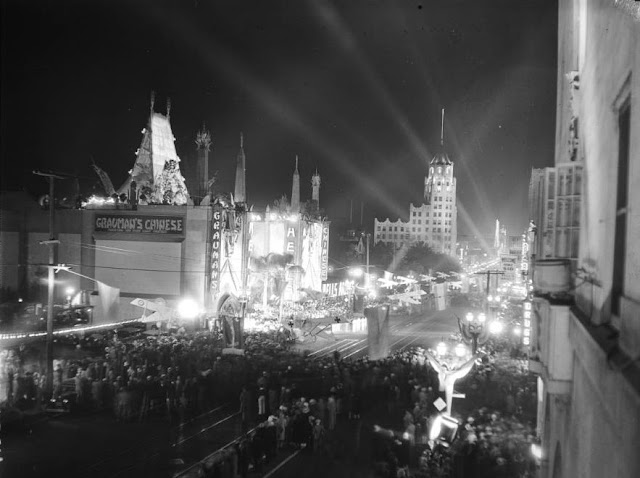 1930 – The May 27 premiere of the Howard Hughes production “Hell’s Angels.” It’s a photo in the USC Digital Library collection. The film ran eighteen weeks.
1930 – The May 27 premiere of the Howard Hughes production “Hell’s Angels.” It’s a photo in the USC Digital Library collection. The film ran eighteen weeks.
 1930 – Another USC Digital Library view of the “Hell’s Angels” premiere. It’s from the California Historical Society collection.
1930 – Another USC Digital Library view of the “Hell’s Angels” premiere. It’s from the California Historical Society collection.
 1930 – A “Hell’s Angels” premiere view located by intrepid theatre researcher Ken McIntyre. Note the plane parked in front of the theatre.
1930 – A “Hell’s Angels” premiere view located by intrepid theatre researcher Ken McIntyre. Note the plane parked in front of the theatre.
 1930 – A fine look into the forecourt during the “Hell’s Angels” premiere. It’s a USC Digital Library photo from the California Historical Society.
1930 – A fine look into the forecourt during the “Hell’s Angels” premiere. It’s a USC Digital Library photo from the California Historical Society.
1930 – A photo from the Howard Hughes Collection at the AMPAS Margaret Herrick Library. It’s one of a number of theatre photos on display outside the Ted Mann Theatre at the Academy Museum.
 1930 – A terrific photo of the “Hell’s Angels” premiere from the Zimmerman collection appearing in the Angel City Press book “Spectacular Illumination: Neon Los Angeles 1925-1965” by Tom Zimmerman with J. Eric Lynxwiler. The authors note: “In 1930, Olesen’s Spectacular Illumination company was party to one of the most elaborate premieres in Hollywood history. No expense was spared for the debut of Howard Hughes’s Hell’s Angels, and Oleson provided two hundred searchlights, advertising balloons, and created smokescreens in the sky on which he projected the film title.”
1930 – A terrific photo of the “Hell’s Angels” premiere from the Zimmerman collection appearing in the Angel City Press book “Spectacular Illumination: Neon Los Angeles 1925-1965” by Tom Zimmerman with J. Eric Lynxwiler. The authors note: “In 1930, Olesen’s Spectacular Illumination company was party to one of the most elaborate premieres in Hollywood history. No expense was spared for the debut of Howard Hughes’s Hell’s Angels, and Oleson provided two hundred searchlights, advertising balloons, and created smokescreens in the sky on which he projected the film title.”
Chris Nichols discussed the book and included this photo and other Hollywood views with his August 2016 Los Angeles magazine article “These Photos Will Transport You to a Neon-Soaked 1930s Hollywood.” The photo also appears with other discussions of the book on Curbed L.A., City Lab, and the KCRW blog.
 1930 – An amazing look east on Hollywood Blvd. during the run of “Hell’s Angels.” Thanks to Martin Turnbull for finding the photo for a post on his Garden of Allah Novels Facebook page.
1930 – An amazing look east on Hollywood Blvd. during the run of “Hell’s Angels.” Thanks to Martin Turnbull for finding the photo for a post on his Garden of Allah Novels Facebook page.
1930 – The Los Angeles Public Library has this lovely view showing quite an array of signage for “Hell’s Angels.”
more “Hell’s Angels” – premiere from across the street – USC Digital Library | premiere lights on Vine St. – Garden of Allah Facebook page | premiere lights looking east from above – Los Angeles Public Library | premiere lights from Roosevelt roof – Vintage Los Angeles | premiere lights from the hills – El Capitan visible – Mott Studios – Los Angeles Public Library | another daytime street view – Los Angeles Public Library 
1930 – They got out the huge letters for Raoul Walsh’s “The Big Trail,” running from October 2 until November 23. And it was a big film — photographed and projected in a 2 to 1 aspect ratio using the 70mm Fox Grandeur process. The projectors probably were two of the three that earlier had been used at the Carthay Circle. It’s a photo from the Kurt Wahlner collection. Thanks to Kathy Kikkert for including it on page 37 of her wonderful 2023 Angel City Press book “Hollywood Signs: The Golden Age of Glittering Graphics and Glowing Neon.”
 1930 – A Los Angeles Public Library collection photo of the December premiere for Josef von Sternberg’s “Morocco.”
1930 – A Los Angeles Public Library collection photo of the December premiere for Josef von Sternberg’s “Morocco.”
 1930 – A closer look at the “Morocco” premiere. Thanks to Ken McIntyre for locating this for a post on the private Facebook group Photos of Los Angeles.
1930 – A closer look at the “Morocco” premiere. Thanks to Ken McIntyre for locating this for a post on the private Facebook group Photos of Los Angeles.  1931 – The “Miracle Picture of 1931.” It’s the January 22 premiere of “Trader Horn” starring Harry Carey and Edwina Booth. The film played two different engagements at the theatre. Following the premiere it had an 11 week run from January 23 until April 5. It returned for 2 weeks beginning June 11. Thanks to Morbius19 for sharing the photo on Flickr. And kudos to Ken McIntyre for locating the photo for a post on the Photos of Los Angeles Facebook group.
1931 – The “Miracle Picture of 1931.” It’s the January 22 premiere of “Trader Horn” starring Harry Carey and Edwina Booth. The film played two different engagements at the theatre. Following the premiere it had an 11 week run from January 23 until April 5. It returned for 2 weeks beginning June 11. Thanks to Morbius19 for sharing the photo on Flickr. And kudos to Ken McIntyre for locating the photo for a post on the Photos of Los Angeles Facebook group. 
1931 – The first known color image of the theatre, a frame from “Round About Hollywood.” The seven minute short also offers views of the Warner and the Pantages. It’s on Internet Archive from a print released by the UK firm Wardour Films done in the two-color Multicolor process. That firm was later merged into Cinecolor.
Thanks to Kurt Wahlner for spotting the footage online. He turned to Sophia Lorent, a curatorial assistant in the Moving Image Department at the George Eastman House, to determine the origin of the footage. This was shot near the end of the initial engagement of “Trader Horn.”  1931 – “Round About Hollywood” concludes with footage of the April 7 west coast premiere of “Dirigible.” It had a four week run ending May 7.
1931 – “Round About Hollywood” concludes with footage of the April 7 west coast premiere of “Dirigible.” It had a four week run ending May 7.  1931 – Another view of the “Dirigible” premiere. Thanks to Kurt Wahlner for extracting this shot from newsreel footage of the event. The footage can be seen (along with coverage from the “Grand Hotel” premiere) on YouTube as as post from Nass. Thanks to Scott Santoro for locating it.
1931 – Another view of the “Dirigible” premiere. Thanks to Kurt Wahlner for extracting this shot from newsreel footage of the event. The footage can be seen (along with coverage from the “Grand Hotel” premiere) on YouTube as as post from Nass. Thanks to Scott Santoro for locating it. 
1931 – Playing “Merely Mary Ann” with Janet Gaynor and Charles Farrell. It opened September 17 for a three week run. Thanks to Ken McIntyre for locating the card via the site Worthpoint for a post on the private Facebook group Photos of Los Angeles.

1932 – The April 29 premiere for “Grand Hotel.” Thanks to Paul Ayers for locating the photo for a post on the page for the private Facebook group Photos of Los Angeles. The film opened April 30 for an eleven week run. What else played in 1932? See Kurt Wahlner’s films of 1932 page for the whole list.
 1932 – Signage across the street for “Grand Hotel.” This view is one from the newsreel coverage of the premiere that appears on the DVD for the film.
1932 – Signage across the street for “Grand Hotel.” This view is one from the newsreel coverage of the premiere that appears on the DVD for the film. 
1932 – Another “Grand Hotel” premiere view. Thanks to Kurt Wahlner for extracting this shot from the newsreel footage of the event. Nine minutes of footage is on YouTube as “‘Grand Hotel’ Premiere.” It can also be seen on YouTube in a colorized version (along with coverage from the “Dirigible” premiere) as a post from Nass titled “Hollywood, Los Angeles 1930s in color.” Thanks to Scott Santoro for locating it.
Footage from this premiere appears in at least three feature films: “What Price Hollywood” (1932), “It Happened In Hollywood” (1937) and “Babylon” (2022).
 early 30s – Thanks to Brian Michael McCray for this fanciful postcard version of a premiere night. It’s one of over 400 cards in his collection that were once displayed on Picasa until Google discontinued that platform.
early 30s – Thanks to Brian Michael McCray for this fanciful postcard version of a premiere night. It’s one of over 400 cards in his collection that were once displayed on Picasa until Google discontinued that platform.
 1932 – This shot from the Theatre Historical Society Facebook page gives us a fine view of the signage east of the theatre before the July 15 world premiere of “Strange Interlude,” starring Norma Shearer and Clark Gable.
1932 – This shot from the Theatre Historical Society Facebook page gives us a fine view of the signage east of the theatre before the July 15 world premiere of “Strange Interlude,” starring Norma Shearer and Clark Gable.  1933 – The January 12 premiere of “Cavalcade,” directed by Frank Lloyd and produced at Fox Movietone City. Thanks to Eric Lynxwiler for sharing this photo from his collection on Flickr. And also thanks to Michelle Gerdes for spotting Eric’s post and including this in the Los Angeles Historic Theatre Foundation Group Pool on Flickr.
1933 – The January 12 premiere of “Cavalcade,” directed by Frank Lloyd and produced at Fox Movietone City. Thanks to Eric Lynxwiler for sharing this photo from his collection on Flickr. And also thanks to Michelle Gerdes for spotting Eric’s post and including this in the Los Angeles Historic Theatre Foundation Group Pool on Flickr.  1933 – A detail from the “Cavalcade” photo. Thanks, Eric!
1933 – A detail from the “Cavalcade” photo. Thanks, Eric!  1933 – A great crowd shot at the “Cavalcade” premiere Thanks to Paul Ayers for locating the photo for a Photos of Los Angeles private Facebook group post.
1933 – A great crowd shot at the “Cavalcade” premiere Thanks to Paul Ayers for locating the photo for a Photos of Los Angeles private Facebook group post.  1933 – A postcard view by F.A. Bussey looking east toward the Chinese. Note the signage on the side wall saying “Direction Fox West Coast.” Sid was still around but now working as an employee of Fox West Coast Theatres. Thanks to Sean Ault for spotting this one when it was for sale online. There’s a version of the card in the California State Library collection. That one was issued as a “Frasher Foto Card” with no mention of Mr. Bussey. At the El Capitan the banner is advertising “Otto Kruger – in person – Counselor At Law – Smash Hit of Season.” It opened Easter Sunday, April 16. The Times noted in their June 13 issue that the play was in its ninth and final week. Their next attraction was to be “Twentieth Century,” opening on the 22nd.The Chinese had finished their three week run of “King Kong” on April 13 and, after being dark for seven weeks, opened “Gold Diggers of 1933” on June 2. That film’s eleven week run ended August 13. Kurt Wahlner notes that the photo was taken during the dark period as there’s nothing on the readerboard east of the Chinese.
1933 – A postcard view by F.A. Bussey looking east toward the Chinese. Note the signage on the side wall saying “Direction Fox West Coast.” Sid was still around but now working as an employee of Fox West Coast Theatres. Thanks to Sean Ault for spotting this one when it was for sale online. There’s a version of the card in the California State Library collection. That one was issued as a “Frasher Foto Card” with no mention of Mr. Bussey. At the El Capitan the banner is advertising “Otto Kruger – in person – Counselor At Law – Smash Hit of Season.” It opened Easter Sunday, April 16. The Times noted in their June 13 issue that the play was in its ninth and final week. Their next attraction was to be “Twentieth Century,” opening on the 22nd.The Chinese had finished their three week run of “King Kong” on April 13 and, after being dark for seven weeks, opened “Gold Diggers of 1933” on June 2. That film’s eleven week run ended August 13. Kurt Wahlner notes that the photo was taken during the dark period as there’s nothing on the readerboard east of the Chinese. 